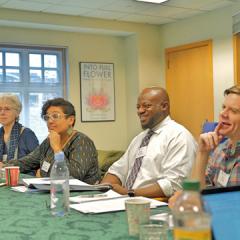Donna Hicks on Dignity and the Important Role It Plays In Our Lives
Donna Hicks is the author of Dignity: The Essential Role it Plays in Conflict and Leading With Dignity: How to Create a Culture that Brings Out the Best in People. An associate at the Weatherhead Center for International Affairs at Harvard University, Dr. Hicks has worked in the field of international and intercultural conflict resolution for nearly three decades, collaborating with figures such as Desmond Tutu in the process. She shares essential findings from her career at this 2015 event.
By Mitch Bogen
When Donna Hicks first hit on the concept of dignity as a way to understand conflict, she learned two things fast. One was that people were very receptive to the concept and eager to use the lens of dignity to understand the conflicts they were in and the pain they were feeling. The other was that, despite the near universality of agreement that dignity is crucial, most of us have a pretty shallow understanding of what it is and how it impacts us. With this awareness, Hicks set out to research, understand, and apply dignity in the context of her work as a conflict resolution specialist to organizations, communities, and countries.
On January 31, 2015, Dr. Hicks shared many of her findings with a capacity crowd that gathered at the Ikeda Center’s Cambridge meeting space on a cold but clear day that landed, fortunately, right in between two massive snowstorms. Dignity, she said by way of introduction, is not about conflict so much as it is about being human. Unfortunately, as any survey of the news both near and far reveals, there is an “epidemic of indignity in our world.” In fact, Hicks said she “has not met a single person who hasn’t had an experience of indignity” – which is why she endorses John Naisbitt’s contention that “the most exciting breakthrough of the 21st century will not occur because of technology, but because of an expanding concept of what it means to be human.”
Toward Mandela Consciousness
Hicks’ own breakthrough with the dignity model came after working all around the world for several years with colleagues from Harvard’s Weatherhead Center for International Affairs. They worked to bring parties together in negotiation – parties who often qualified as among the most politically influential people in their countries. However, after a while she realized that the strongest force at these negotiating tables was located not in the words that were being spoken by these “best and brightest,” but in a powerful emotional undercurrent that was blocking communication; a silent conversation that if given voice would say, “How dare you treat us this way.” Sensing that many of these leaders would consider it “weak” to talk about emotions, Dr. Hicks intuited that if the conversation were to be framed in terms of dignity, good things could happen.
Her chance to test this theory came in 2004 when she was facilitating conversations between the Republic of Columbia’s military and its department of defense, whose communications had broken off terribly. Hicks recalled how she initially had been met with eye-rolling skepticism by these proud men, who were there not out of choice but by order of the president. But her intuition was soon vindicated. When Hicks asked them to talk about times not only when their dignity had been violated but also when they had violated someone else’s, suddenly “everybody had a story,” said Hicks. And after two days of dignity-based discussion, participants were engaged, the room was transformed, and relations were on their way to being restored. With this, Dr. Hicks’ many-year journey of discovering dignity and its power began.*
So what exactly is dignity? Dr. Hicks posed this to the audience as a brainstorming question and received some quick suggestions. Validation, said one person; respect, said another. Others suggested inherent worth and true worth. More good ideas included the presence of equality, the act of honoring, and the state of being non-judgmental.
Before proceeding to further discussion of these and other qualities, Hicks explained that after all her years of research, she has determined that dignity is “so deeply emotional and spiritual” that we easily run the risk of over-analysis. As a corrective, Hicks displayed a simple image to communicate dignity’s essence. In the image, a newly born infant is being held tenderly in a man’s hands, hands nearly as large as the baby itself. Here, said Dr. Hicks, are the two core truths of dignity. The first is that dignity is a state of “inherent value and worth.” Who would deny the miraculous beauty and dignity of the child? It is this inherent quality that differentiates dignity from respect, which, Hicks said, is something that we earn through our actions.
This truth of inherent worth, however, is balanced by the truth that our dignity is vulnerable. It’s clear to viewers that the baby is physically vulnerable, but the image of it being tenderly held also suggests a metaphor for the way our dignity should be treated, but too often isn’t. Looking at this image, said Hicks, it’s “astonishing” to see how we choose to hurt one another. Continuing, Hicks said that what’s really interesting, though, is that the vulnerability of dignity isn’t just a metaphor. Projecting a slide showing two brain scans produced by researchers** at UCLA, Hicks explained that physical wounds and dignity wounds light up exactly the same areas of the very “primal area” of our brain called the limbic system – so dignity isn’t an abstract concept after all. The trouble is, said Hicks, that while we have emergency rooms for physical injuries, they don’t exist for the dignity kind. Compounding the problem is the reality that because of shame, dignity wounds tend to stay more hidden than physical ones. For this reason, Donna Hicks agrees with international public health activist Paul Farmer that assaults on dignity constitute one of the “biggest global health threats that we are facing.” There is so much suffering happening that needn’t, she said.
What to do? Well, the main thing we can do for ourselves is to develop what Hicks calls “Mandela consciousness.” What this means is that we must do what Nelson Mandela did when he was sent to the Robben Island prison in 1964 (commencing 27 years of incarceration), and recognize that our dignity is always within our own care and control. People can try to harm it, as the guards at Robben Island did, but as Mandela proved so vividly, no one can destroy our dignity without our consent. Most of us, thankfully, will never face such circumstances, but we all can benefit from attention to nurturing resilience in ourselves and others. In fact, said Hicks, it is nothing less than our responsibility to care for our own dignity and that of others – to be the “stewards and caretakers” of the “gift” of dignity, as one of her former students so beautifully phrased it.
Biology Isn’t Destiny
Dr. Hicks then turned to a discussion of the ten elements of dignity, which she describes as the qualities we extend to others and would like for ourselves, in order for dignity to flourish. Or put another way: What does it look like to honor dignity? All ten are key, but she highlighted three in particular that can make a big difference.
- Acknowledgement. This act has almost “magical” powers and a “disarming” effect, said Hicks, since the last thing the other party in a conflict ever expects is for their viewpoint to be acknowledged. Receiving this validation helps them open up to healing.
- Safety. Physical safety is something we understand. But safety comes in many forms. One very important example is that in hierarchical situations, such as those that define most of our organizations, individuals need to know that it’s safe to speak up about problems or injustices. The truth, said Hicks, is that in too many of our organizations, people remain “terrified” to speak the truth about their experience.
- Benefit of the doubt. This one is “huge,” Hicks said. Avoiding the “rush to judgment” is always hard, especially so in conflict situations. But when we give people the benefit of the doubt, and assume the best rather than the worst, good things happen. People will act exactly how you label them, she suggested. If, for example, you think someone is distrustful, “you’re going to get that back.”
Next, Dr. Hicks introduced what she calls “the ten temptations” to harm or subvert dignity. The main thing to know about these temptations is that they don’t represent moral failings so much as unconscious acting out of certain evolutionary inheritances that incline us toward self-preservation. But the situation is far from hopeless. Quoting an evolutionary biologist, Hicks said, “Biology is not destiny unless we ignore it.” So what should we do to avoid these evolutionary traps? Hicks shared a few examples.
- Don’t get caught in the temptation to save face. Think Lance Armstrong. Cover-ups and deceit rarely make a situation better. Ironically, “it takes strength to be vulnerable,” she said, and in so doing, we are usually met with acceptance or even approval.
- Don’t be lured by false dignity. Looking outside ourselves for validation is a slippery slope that can lead to over-dependence on others for our wellbeing. False dignity is the opposite of “Mandela consciousness.”
- Don’t be lured by false intimacy. When we’ve been hurt, there’s a temptation to bond with others through behaviors such as gossiping. Hicks’ advice? Don’t do it. Gossiping is where the energy goes when the pain of indignity is suppressed, she explained, and in the process the chances for positive transformation dwindle.
This is all easier said than done, of course. Hicks even describes herself as “a recovering dignity violator.” Indeed, the temptation to violate someone’s dignity is no further away than the next encounter with a customer service representative from any large institution. “When you really understand” how deep and universal this challenge is, said Hicks, “you have a lot of compassion for yourself and you also have a lot of compassion for other people.”
One effective way to avoid violating dignity, continued Hicks, is “to hit the pause button.” Another metaphor is suggested by Harvard’s Ron Heifetz, who says that when conflict starts, we need to “go to the balcony.” This means that before things escalate we should find a way to observe ourselves dispassionately, as if looking down on the situation from above. The goal is to give ourselves enough time to get the neocortex, the more recently evolved, less reactive region of the brain involved. The practice of meditation is one good way to foster this ability and to become less reactive in general, said Hicks.
Dr. Hicks concluded her prepared remarks with a lesson she learned from her friend and colleague Archbishop Desmond Tutu about the best way to pursue the often-difficult work of resolving conflict and restoring dignity. She and the archbishop were working together on a BBC television project that facilitated dialogue between victims and perpetrators from the long, violent struggle between the Irish Republican Army and the British. The days featured long hours of taping and tense conversations. At the end of the first day, the producers wanted to meet again later for some debriefing. To everyone’s surprise, the archbishop rejected the idea, exclaiming, “Don’t you dare do that!” He said that everyone had already experienced too much negativity and tension for one day. What was needed, he said, was joy and positivity – preferably in the form of dancing, cocktails, and laughter. And so it went for the duration of the filming of what turned out to be a stellar production called Facing the Truth, which aired in 2006.
Q & A: The Future of Dignity
The final portion of the event was devoted to Q & A with the audience, which included many longtime friends as well as new friends such as students representing the Brandeis University Amnesty International group and students studying negotiation and collaborative problem solving at Simmons College. Also in attendance was Herbert Kelman of Harvard University, Dr. Hicks’ mentor in the theory and practice of conflict resolution. Among the topics discussed, too many to cover here, a few central themes emerged.
One had to do with the sensitivity of dealing with and possibly re-opening dignity wounds that are either traumatic or multi-generational in nature. In terms of the former, Dr. Hicks emphasized again the importance of creating safe environments where individuals feel free to tell their stories without fear of consequence or judgment. She shared that the work of Judith Herman on trauma and recovery is a valuable resource. Earlier, Hicks had mentioned that we often pass the pain of our ancestors down “like dominant genes.” Now she added that what’s needed is to break the cycle of victimization. This happens when, first, the wounded parties understand that though they have been mistreated, they and/or their ancestors haven’t done anything wrong, and next, when they summon the personal strength to form or join positive cultures of resilience. Often a process of mourning is involved as well, said Hicks.
Other comments dealt with the challenge of developing leaders who are both sensitive to and active in the cause of dignity. The key thing to understand here is that the dignity model is “an educational model.” We are doing nothing less, Hicks reiterated, than “educating ourselves about what it means to be a human being.” Much of that learning happens outside of schools, of course, but plenty of good dignity work is happening in our schools now, too. Hicks cited schools she has worked with in places as diverse as Brooklyn and Fort Worth, with children as young as the fourth grade offering what she called “profound” insights into what dignity means. So a new generation of dignity leaders and “ambassadors” is rising, she said. On the other hand, the situation with current leaders is mixed. Many business and organizational models are still rigidly hierarchical, Hicks observed, but change is definitely happening. For example, Dr. Hicks has worked with a leadership team at Mt. Auburn Hospital in Cambridge in which representatives ranging from surgery to facilities maintenance are given an equal voice.
Near the end of the afternoon, a student asked about the role of forgiveness in the restoration of dignity. Hicks responded that “in the international conflict field,” forgiveness is the concept that “drives things.” But in truth, said Dr. Hicks, some acts are simply “unforgiveable.” Furthermore, as important as forgiveness can be, the restoration of dignity does not require it. Referring again to Facing the Truth, Hicks recalled how two men participating in the project reconciled not through forgiveness but through the recognition of shared humanity. The men in question were an IRA volunteer named Ronnie and the British police officer he nearly killed many years earlier. After both men had time to tell their stories, the officer was asked how he felt about what happened. To everyone’s surprise, he said that now that he understood how Ronnie had been forced to grow up like a second-class citizen in his own country, if he himself had been in that position, he might also have taken up arms. Reconciliation happened not because of forgiveness, Hicks said, but because of the officer’s “identification with the indignity Ronnie had faced.”
To conclude, Dr. Hicks acknowledged that dignity violations can be “painful stuff.” In fact it was her own desire to heal from dignity wounds she suffered when young that started her on her current path, which now seeks nothing less than healing on a global scale. And “the healing really happens,” she said. “This really works.”
Notes
* In 2011 Dr. Hicks shared her initial discoveries and insights in a book called Dignity: Its Essential Role in Resolving Conflict (Yale University Press).
** Husband and wife neuroscience team Matthew Lieberman and Naomi Eisenberger.



